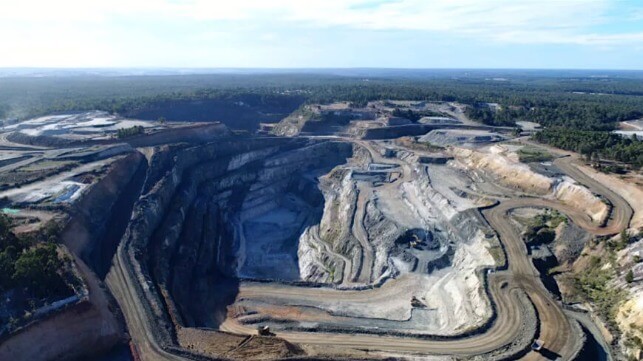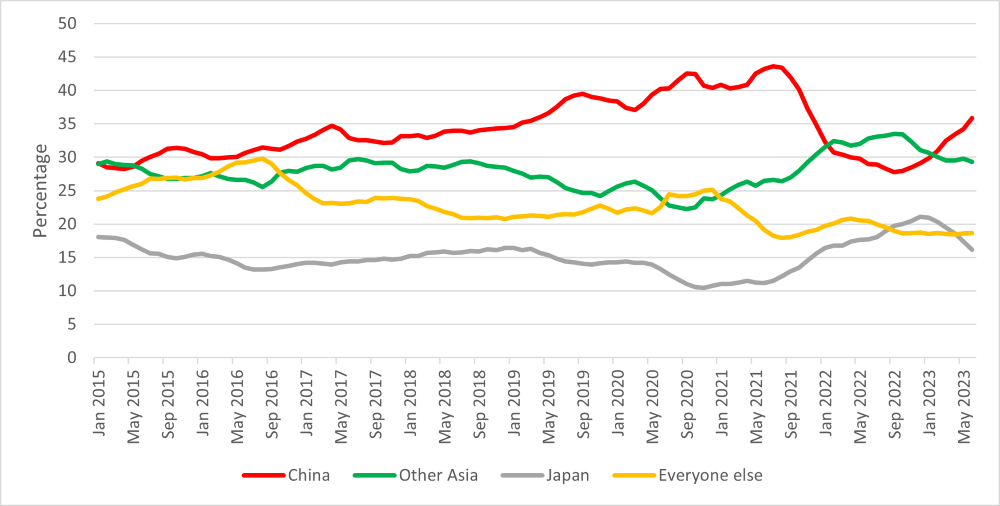Australian Exports to China Come Roaring Back, Led by Lithium

[By David Uren]
The Chinese economy may be softening and commodity prices falling, but Australia’s exports to China hit a record $102.5 billion in the first half of this year thanks to massive shipments of lithium concentrate.
Lithium has overtaken liquefied natural gas as Australia’s second biggest export to China behind iron ore, with sales rocketing to $11.7 billion between January and June. Two years ago, first-half sales of lithium to China reached only $470 million.
China is taking almost all of Australia’s lithium output, underlining its dominance of both critical-minerals processing and of the energy transition more generally. Apart from China, just 2% goes to Belgium and 1% each to the United States and Korea, according to the Department of Industry, Science and Resources.
While the development of a major new export commodity is a boon to the economy, especially at a time when prices of other exports are sliding, China’s capture of the lithium market runs counter to the warning in the Australian government’s new critical minerals strategy of the danger of excessive reliance on a single customer.
The strategy declared that the ‘risks of disruption to critical mineral supply chains are heightened when mineral production or processing is concentrated in particular locations, facilities or companies’. Australia’s strategy was to work with like-minded governments’ to diversify supply chains.
Detailed trade data from the Department of Foreign Affairs and Trade shows that the diversification of export markets during China’s two-year campaign of economic coercion of Australia was short-lived. Sales to most of Australia’s other principal trading partners have been falling sharply as sales to China recover.
When China embarked on its campaign of economic coercion, Australia was saved by its other Asian trading partners (see chart below). China’s share of Australia’s exports had peaked at 43% in May 2020 but plunged to 28% by the middle of last year.

Source: Australian Bureau of Statistics (six-month rolling total)
The slack was picked up by Japan, whose share of Australia’s exports went from 11% in mid-2020 to 21% by September last year, and by other Asian nations whose combined share rose from 22% to 34%, comfortably overtaking China.
But with China’s share climbing back to 36% in the first half of this year, Japan’s share has dropped back to 16% and the rest of Asia is now taking just 29%.
Australian coal sales to China stopped entirely during 2021 and 2022, causing huge shifts in the global coal trade. China started buying coal from Indonesia, which then cut its sales to India and elsewhere. India boosted its purchases of Australian coal that had previously gone to China.
These flows have now reversed. India’s purchases of Australian coal, for example, went from around $1.5 billion a month to $2.5 billion a month through much of last year, but are now back to about $1.3 billion. China is now spending about $1 billion a month on Australian coal.
China has also returned to purchasing Australian oil, with sales rising from nothing to $860 million in the first half of the year. Although never put on China’s list of banned Australian purchases, imports of wheat and other cereals (excluding barley) have risen rapidly from $500 million in the first half of 2021 to $3.1 billion so far this year.
The trade figures to the end of June don’t show any Australian exports of barley, for which China has only just agreed to drop its punitive tariffs. Tariffs remain on wine, and at the end of June, China still had trade bans on Australian copper ores, wood chips, timber and crayfish.
Total Australian exports to China rose by 22.4% in the first half of the year, despite a sharp, and continuing, fall in commodity prices.
China’s capture of Australia’s lithium exports highlights the tension between economic forces and strategic policy. The government favors investment from Western nations and its clear preference is to build supply chains with Western partners that bypass China.
The Foreign Investment Review Board has been knocking back efforts by Chinese companies to invest in the Australian critical-minerals industry. For example, it has vetoed moves by a company directed by a Chinese national, Astroid Australia, to purchase 90% of lithium miner Alita Resources and prevented Yuxiao Fund from increasing its 9.9% stake in rare-earths miner Northern Minerals.
However, China has been building its expertise in critical minerals since the 1980s. Its unrivaled lead in processing and manufacturing technology makes it the obvious choice for buyers wanting quality refined critical minerals.
More broadly, the concentration of export markets in China exposes Australia to the impacts of both downturns in the Chinese economy and future geopolitical tensions between the two countries. However, the experience of the past two years, when the Australian economy barely noticed the impact of China’s trade strikes, underlines the flexibility and adaptability of international markets.
David Uren is a senior fellow at ASPI. This article appears courtesy of ASPI's The Strategist, and it may be found in its original form here.
